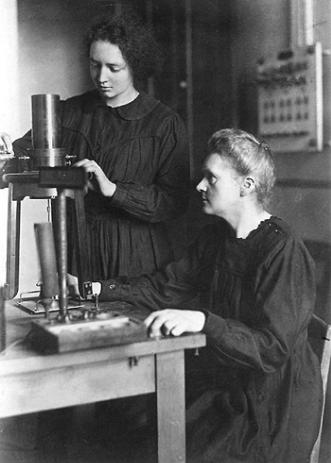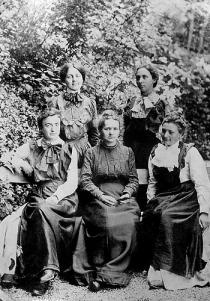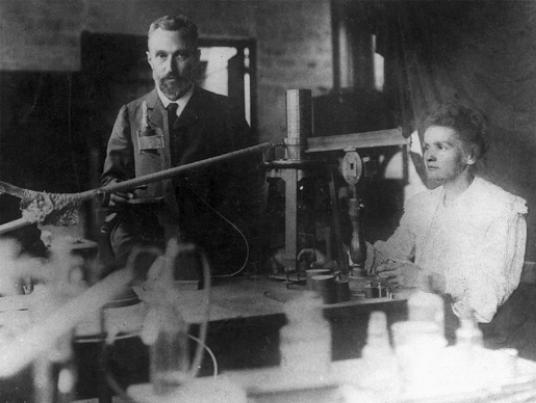
0647126_DA545_nadeina_l_v_radioekologiya
.pdfAtoms and Elements
Elements are the building blocks of matter. The smallest particle of an element that still retains the identity of that element is the atom. All atoms of a given element are identical to one another, but differ from the atoms of other elements. Ancient Greeks first predicted the existence of the atom around 500 BC. They named the predicted particle «atomos», meaning «indivisible».
In 1803, John Dalton (1766-1844) proposed a systematic set of postulates to describe the atom. Dalton's work paved the way for modern day acceptance of the atom. But scientists of his day considered the atom to be merely a subordinate player in chemical reactions, an uninteresting, homogeneous, positively charged «glob» that contained scattered electrons. That premise remained unchallenged until the end of the nineteenth century, when a series of brilliant discoveries opened the door on the atomic science of the twentieth century. Working concurrently and often collaboratively, three pioneering scientists helped release the genie of the atom.
Antoine Henri Becquerel
Becquerel, a French physicist, was the son and grandson of physicists. Becquerel was familiar with the work of Wilhelm Conrad Roentgen on December 22 1895, «photographed» his wife's hand, revealing the unmistakable image of her skeleton, complete with wedding ring. Roentgen's wife had placed her hand in the path of X-rays which Roentgen created by beaming an electron ray energy source onto a cathode tube. Roentgen's discovery of these «mysterious» rays capable of producing an image on a photographic plate excited scientists of his day including Becquerel. Becquerel chose the study related phenomena of fluorescence and phosphorescence. In March of 1896, quite by accident, he made a remarkable discovery. Becquerel found that, while the phenomena of fluorescence and phosphorescence had many similarities to each other and to X-rays, they also had important differences. While fluorescence and X-rays stopped when the initiating energy source was halted, phosphorescence continued to emit rays some time after the initiating energy source was removed. However, in all three cases, the energy was derived initially from an outside source. In March of 1896, during a time of overcast weather, Becquerel found he couldn't use the sun as an initiating energy source for his experiments. He put his wrapped photographic plates away in a darkened drawer, along with some crystals containing uranium. Much to his Becquerel's surprise, the plates were exposed during storage by invisible emanations from the uranium. The emanations did not require the presence of an initiating energy source– the crystals emitted rays on their own! Although Becquerel did not pursue his discovery of radioactivity, oth-
31
ers did and, in so doing, changed the face of both modern medicine and modern science.
Ernest Rutherford and the Atom
In 1911, Rutherford conducted a series of experiments in which he bombarded a piece of gold foil with positively charged (alpha) particles emitted by radioactive material. Most of the particles passed through the foil undisturbed, suggesting that the foil was made up mostly of empty space rather than of a sheet of solid atoms. Some alpha particles, however, «bounced back», indicating the presence of solid matter. Atomic particles, Rutherford's work showed, consisted primarily of empty space surrounding a well-defined central core called a nucleus.
In a long and distinguished career, Rutherford laid the groundwork for the determination of atomic structure. In addition to defining the planetary model of the atom, he showed that radioactive elements undergo a process of decay over time. And, in experiments which involved what newspapers of his day called «splitting the atom», Rutherford was the first to artificially transmute one element into another– unleashing the incredible power of the atom which would eventually be harnessed for both beneficial and destructive purposes. Taken together, the work of Becquerel, the Curies, Rutherford and others, made modern medical and scientific research more than a dream. They made it a reality with many applications. A look at the use of isotopes reveals just some of the ways in which the pioneering work of these scientists has been utilized. Radiation is a two edged sword: its usefulness in both medicine and anthropological and archaeological studies is undisputed, yet the same materials can be used for destruction. Human curiosity drove inquiring scientists to harness the power of the atom. Now humankind must accept the responsibility for the appropriate and beneficial uses of this very powerful tool.
(www: The Discovery of Radioactivity The dawn of the nuclear Age.htm )
6.1 Answer the questions.
1.How did our conceptions of atomic properties change?
2.How has that change affected our lives and our knowledge of the world?
3.What did the predicted particle «atomos» mean?
4.Who first predicted the existence of the atom around 500 BC?
5.How many pioneering scientists working concurrently and often collaboratively helped release the genie of the atom?
32
6.Who chose the study related phenomena of fluorescence and phosphorescence?
7.When did Becquerel find that he couldn't use the sun as an initiating energy source for his experiments?
8.What did Rutherford's work show?
9.What did Rutherford show in addition to defining the planetary model of the atom?
Grammar in Use
7. Read the texts and fill in the missing words (the verbs in Passive Voice, see the table Passive Voice, p. 9).
A) to be observed, to be recognized, to be known, to be discovered, not to be understood, not to be recognized, not to be appreciated, to be
awarded
Although radiation 1)……………………in late 19th century, the dangers of radioactivity and of radiation 2)…………. immediately ……… . Acute effects of radiation 3)………….. first …………….. in the use of X- rays when the Serbo-Croatian-American electric engineer Nikola Tesla intentionally subjected his fingers to X-rays in 1896. He published his observations concerning the burns that developed, though he attributed them to ozone rather than to X-rays. His injuries healed later.
The genetic effects of radiation, including the effects on cancer risk, 4)……………….. much later. In 1927 Hermann Joseph Muller published research showing genetic effects, and in 1946 5)………………… the Nobel prize for his findings.
Before the biological effects of radiation 6)……………….., many physicians and corporations had begun marketing radioactive substances as patent medicine and radioactive quackery. Examples were radium enema treatments, and radium-containing waters to be drunk as tonics. Marie Curie spoke out against this sort of treatment, warning that the effects of radiation on the human body 7)………… well ………….. . Curie later died of aplastic anemia due to radiation poisoning. Eben Byers, a famous American socialite, died in 1932 after consuming large quantities of radium over several years; his death drew public attention to dangers of radiation. By the 1930s, after a number of cases of bone necrosis and death in enthusiasts, radium-containing medical products had nearly vanished from the market.
33
Nevertheless, dangers of radiation 8)……………. fully ………. by scientists until later. In 1945 and 1946, two U.S. scientists died from acute radiation exposure in separate criticality accidents. In both cases, victims were working with large quantities of fissile materials without any shielding or protection.
Atomic bombings of Hiroshima and Nagasaki resulted in a large number of incidents of radiation poisoning, allowing for greater insight into its symptoms and dangers.
B) to be surprised, to be seized, to be emitted, to be established, to be extracted, to be found, to be accompanied, to be overcast, to be known
Knowledge concerning atomic nuclei began as early as 1896 with discovery of radioactivity.
In 1895, Roentgen discovered the X-rays. The French scientist Becquerel got interested in Roentgen’s work. Becquerel 1) ……………… of the fact that the production of X-rays 2) …….. always ……….. by fluorescence from the material of the X-ray tube (glass). He thought that X-rays existed whenever there was fluorescence. To investigate this problem, Becquerel took uranium sulphate, which fluoresces under the action of sunlight. He found that fluorescent uranium sulphate did give out rays, which could affect a photographic plate even when wrapped in thick black paper. Becquerel argued that the fluorescent salt had given rise to X-rays, which had penetrated the black paper and affected the photographic plate.
But he soon saw that he was mistaken. During one such experiment the sky happened 3) …………… and uranium salt was hardly fluorescent. On developing the photographic plate, Becquerel 4) ……………….. to see a dark spot on it, as before. He had obviously stumbled on some new kind of rays (1896) which could penetrate the thick wrapper and affect the photographic plate. It 5) ……. soon ……….. that any salt of uranium emits Becquerel rays. Unlike the X-rays, which appear in an X-ray tube only under special conditions, the Becquerel rays 6) ……………….. in a spontaneous manner.
Is uranium the only substance emitting Becquerel rays? Marie Curie found the pitchblende, the ore from which uranium 7) ……………….. emits Becquerel rays with a much stronger intensity than what its uranium content would. After a long and laborious process of chemical separation, Marie Curie and her husband Pierre Curie discovered two new elements, polonium and radium, which emitted Becquerel rays.
34
They gave the name «radioactive» to all substances capable of emitting Becquerel rays and the phenomenon itself came to 8) ……………….. as it 9) ……………. To be about a million times more radioactive than uranium. This power of radium radiation made it possible to study radioactivity systematically.
8. Mind the meaning of the following words and use them to read the text bellow.
English |
Russian |
achieve |
добиваться, достигать |
afford |
приносить, доставлять |
astonishing |
ошеломительный, изумительный |
artificial |
искусственный |
breakdown |
распад, разрушение |
cancer |
рак (болезнь) |
clue |
ключ (к разгадке чего-л.) |
cumulative |
совокупный, накопленный |
current |
поток, течение |
distinguished |
выдающийся, знаменитый |
emit |
испускать, выделять |
establish |
устанавливать |
exposure |
внешнее воздействие |
excitation |
возбуждение, воздействие |
fame |
известность, слава |
fund |
запас, резерв |
genius |
гений |
impact |
сильное воздействие, влияние |
intensity |
мощность, энергия |
investigation |
исследование, изучение |
isolate |
изолировать, выделять |
lack |
нехватка, потеря, недостаток |
outward |
наружный, внешний |
piezoelectricity |
пьезоэлектричество |
pitchblende |
уранинит, урановая смолка |
polonium |
полоний |
radium |
радий |
radiotherapy |
радиотерапия, рентгенотерапия |
regard |
внимание, забота |
|
35 |

scintillation |
вспышка люминесценции |
spinthariscope |
спинтарископ |
subsequent |
последующий, следующий |
substance |
вещество |
stirring |
побуждение, стимул |
thallium |
таллий |
8.1 Read the text «The Curies: Lives Devoted to Research»
Wedding photo of Pierre and Marie Curie, 1895.
Marie Curie, her husband Pierre and their daughter Irène were responsible for the discovery of radioactivity and subsequent research work. Polis French chemist and physicist famous for discovering radioactivity Marie Sklodowska was born in Warsaw in 1867. She was a brilliant student and dreamed of studying at the Sorbonne in Paris but it took eight years of saving before she could afford to go. Despite very poor living conditions, and a lack of French, she graduated in physics in 1893 and mathematics in 1894. While looking for a laboratory in Paris to continue with her experiments she was introduced to Pierre Curie, a highly regarded professor at the School of Physics. They married and joined forces in the laboratory to astonishing effect – they soon made the fantastic discovery of radium and radioactivity.
In 1903 Marie and Pierre Curie were awarded half the Nobel Prize in Physics «in recognition of the extraordinary services they have rendered by
36

their joint researches on the radiation phenomena discovered by Professor Henri Becquerel». Pierre was tragically killed in 1906, leaving Marie with two daughters: Irène aged 9 and Eve aged 2. Marie was determined to continue their work. She became the first ever woman professor at the Sorbonne and as well as teaching, she discovered how to isolate radium in metallic form
Marie Curie and her daughter Irène in the laboratory at the Radium Institute in Paris, France, 1921.
37

In 1911 she was awarded the Nobel Prize for Chemistry for the discovery of the elements radium and polonium. This she achieved by the isolation of radium and also from her study of the nature and compounds of this remarkable element. During World War One she established a front-line X-ray service in the battlefields of Belgium and France, tirelessly fundraising, training staff and driving the X-ray vans. After the war, along with her research, Marie continued to fund raise, this time for her Institutes and for a hospital and laboratory devoted to radiology. She eventually died in 1934 from the cumulative effects of radiation exposure.
In April 1895 Marie and Pierre Curie’s remains were enshrined in the Pantheon in Paris. Marie Curie is the first woman to be honoured in such a way for the achievements she made in Physics. Marie met Albert Einstein at the first Solvay Conference of the world’s leading physicists. They became friends and in 1913 went on a walking holiday together with their children. Einstein said of Marie «[she was] the only person not corrupted by fame».
Marie Curie and her daughter Irène at the Hoogstade Hospital in Belgium, 1915. Radiographic equipment is installed.
Pierre Curie met Marie Sklodowska when he was 35 years old and already an internationally recognized physicist. With his brother Paul-Jacques, he discovered piezo-electricity: the fact that crystals under pressure produce
38

electric currents. He also studied crystal symmetries and the magnetic properties of bodies at different temperatures. His papers had been well received by distinguished colleagues but he was still an outsider in the French academic community. Like Marie he did not care for outward distinctions or a career. They married in July 1895.
Pierre followed his wife’s work closely and he and his brother made her an electrometer which measured weak electrical currents, based on the piezoelectric effect. After the exciting results of Marie’s early experiments Pierre abandoned his passionate study of crystals to join her in her search for new substances.
He continued to construct pieces of laboratory equipment such as the ionisation chamber. Together they laboured Marie carrying out the chemical separations and Pierre taking the measurements. Together they discovered polonium and radium and used the word «radioactivity» for the first time.
This sensitive device was developed by Pierre Curie for investigations into radioactivity. The chamber consists of a positive and negative plate connected by an electrometer. Radiation ionises the air in the chamber. The breakdown of air molecules into positive and negative ion pairs allows them to act as carriers of electric current. The negative ions migrate to the positive plate and the positive ions to the negative plate. This causes a weak electric current to flow which can be measured on the electrometer. The level of radioactivity will determine the strength of the current.
Marie Curie and four of her students. (Photo taken between 1910 and 1915.)
39

At a Royal Institution Lecture in London in 1903, Pierre described the amazing properties of radium and the medical tests he had been carrying out on himself. He had tied a piece of radium to his arm for ten hours and then studied the burn-like wound that left a permanent scar. Because of this, Pierre observed the potential of radium in treating cancer. In 1903 Marie and Pierre Curie were awarded half the Nobel Prize.
Irene Joliot-Curie … was born in the stirring days of radioactivity when her parents [Marie and Pierre Curie] were making great discoveries, she grew up with radioactivity, and all her life was devoted to its study.
In 1926 she married Frédéric Joliot … and there began a collaboration of husband and wife in scientific work rivalling in productive genius even that of her parents. The most outstanding of their joint papers were published in the years 1932-1934.
Pierre and Marie Curie in the «hangar» at l’Ecole de physique et chimie industrielles in Paris, France, where they made their discovery. (Photo taken 1898.)
This was followed by a systematic study of the radiations emitted from the lighter chemical elements under the impact of alpha-particles, which through the light of intuition – and good technique – led them, in early 1934, to their beautiful discovery of artificial radioactivity. Then, after studying the conditions of excitation of neutrons by the impact of alpha-particles on vari-
40
